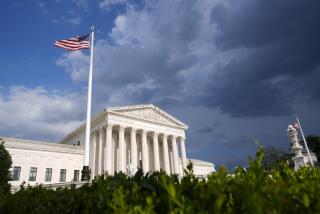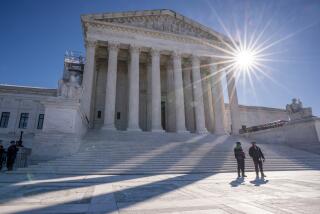THE NATION : TERM LIMITS : Reading Today’s Bias Into ‘Original Intent’
- Share via
STANFORD — The surprising aspects of the U.S. Supreme Court’s decision last week prohibiting states from imposing term limits on members of Congress do not lie in the result. Most legal observers expected the court to reach this conclusion--affirming that so fundamental a change in the political character of the federal government can be made only by constitutional amendment.
The surprise lies elsewhere: in the narrow 5-4 margin and in the curious reversal of positions that enabled the majority to vanquish the dissenters on the chosen ground that three of them--Justices Clarence Thomas, Antonin Scalia, and William H. Rehnquist--avowedly prefer to defend. For whatever else it accomplishes, the decision in U.S. Term Limits vs. Thornton is an ironic victory for the original meaning of the Constitution against those who insist that fidelity to the intentions of its Framers offers the most sound constitutional interpretation.
The idea that originalism (as it is called) is the one true rule of interpretation came to the fore during the mid-1980s--when Atty. Gen. Edwin Meese III called for a return to a “jurisprudence of original intention.” The rejection of the Supreme Court nomination of Robert H. Bork, its chief prophet, was widely taken as a defeat for this school. But appeal to the original intentions or meaning of the Constitution is a recurring trope in U.S. jurisprudence and politics--even when it is clear that the real controversy is not about what happened in 1787 but what should happen today.
The court’s division over term limits confirms that we should expect to see a continuing dispute, in the months and even years to come, over which of two old “stories” gives a better account of the character of the federal Union and Constitution. The originalist story that the majority just barely affirmed is the one that gained strength with the Civil War and has prevailed since the New Deal. It emphasizes the preeminence of the national government over the states, and tends to deny that states retained vast sovereign powers they could exercise free of national supervision.
But the story Thomas tells in his dissenting opinion is an old one, too. Its pedigree runs back to the concerns of the Anti-Federalists--who opposed the Constitution and the states’-rights theories of the 1790s. This history emphasizes the limits on national authority, and allocates much power to the states. That the second African American justice to sit on the court joins a tradition usually associated with John C. Calhoun is a mild irony. What matters more is how well the views of Thomas, Scalia and Rehnquist correspond with the dominant views of the new Republican Congress.
Thomas’ dissent thus indicates the lines along which future disputes will be fought. His opinion offers little hard evidence that the Framers of 1787-88 intended or understood that the states would retain the right to set additional qualifications for election to Congress beyond those specified in the Constitution. Instead, he looks to the general powers reserved to the states or the people under the Tenth Amendment.
In his view, it is not enough that the Constitution lists explicit qualifications for election to Congress, or even that it gives the Congress wide authority to revise state electoral regulations. As he sees it, the Tenth Amendment and general principles of federalism give the states the power to impose additional qualifications for election to Congress--including those that would place incumbents at a great disadvantage. For example, requiring them to run as write-in candidates.
The reasons to think that the majority got the story right are straightforward.
First, a scheme of term limits was part of the original Virginia Plan--the starting point of the deliberations at the Constitutional Convention--but it was quickly and unanimously eliminated. Such a rule had been in place under the Articles of Confederation--its first victim, in fact, was James Madison--but it clashed with the Framers’ evident desire to create a national political elite of experienced, not amateur, lawmakers.
Second, though the Framers did discuss additional qualifications for election to Congress beyond the bare requirements of age, residence and citizenship, they found it nearly impossible to specify uniform constitutional rules that would work for all states at all times. The alternative was to empower Congress to adopt additional requirements--of property, for example--at its discretion. But that would only make it possible for a sitting Congress to manipulate the rules to its advantage. Thus, Hugh Williamson, with a foresight that should warm our hearts, warned that such power would enable lawyers, who might well dominate Congress, to “secure future elections . . . to their own body.”
That would still leave open the possibility, however, that the Constitution left the states free to impose additional qualifications. This is the crucial claim that advocates of state restrictions rely on, and which Thomas sought to vindicate. But there are several telling objections.
The first relates to the literal intentions of the Framers. Their chief purpose in drafting the Constitution was to free the national government from its dependence, under the Articles of Confederation, on the legislatures of 13 semi-sovereign states. Why, then, would the Framers trust the state legislatures to impose additional requirements on membership in Congress?
If the states had the theoretical power to impose conditions limiting incumbent representatives to three terms of service, or senators to two--the model preferred by many of the current state initiatives the court just voided--why could they not impose restrictions that would respectively limit members of the two houses to a single term? In short, what was to stop the state legislatures from adopting qualifications that would discourage the new Congress from developing the nationalist qualities that the Framers manifestly hoped to inculcate?
The Framers’ bias against trusting the states was also evident in the Constitution’s second clause. Article I, Section IV empowers the states to set “the times, places and manner of holding elections” for Congress, but it also allows Congress to alter those rules or impose its own.
Supporters of state-based term limits have argued, somewhat dubiously, that this general authority might extend to setting the qualifications of candidates. Even were that the case, it is hard to understand what the Framers could have hoped to gain by empowering the states to disqualify or penalize the same ambitious incumbents who could presumably overturn these electoral laws as soon as they were made.
But the chief historical weakness in the Thomas dissent is that it makes a mockery of the entire debate surrounding the ratification of the Constitution. The controlling issue in that debate was whether the Constitution would create a “consolidated” national government that would run roughshod over the reserved powers of the states. Anti-Federalists repeatedly warned that an emerging oligarchy of congressmen would exploit their broad legislative powers to reduce the states to hollow shells of government. Federalists replied it was absurd to think the state legislatures and the people would continue to elect senators and representatives who would metamorphose into tyrants.
Neither side in this debate thought to dispel these fears by pointing out the remedy that Thomas now insists the states possessed all along. What better solution could there have been to the danger of federal usurpation than to suggest that the states could sharply reduce this danger simply by imposing legal limits on the re-eligibility of members of Congress? What tyranny could they form if they were legally bound to retire after a term or two?
Federalists could have spared themselves a lot of rhetorical exertions by assuring the states that they could create legal barriers to congressional oligarchy, while Anti-Federalists could have quieted their beating hearts with the knowledge that the states could always limit congressional terms, regardless of the voters’ foolish desire to return incumbents to office.
The fact that neither side in the debate of 1787-88 realized that the states possessed such power certainly creates skepticism about Thomas’s interpretation. None of the Constitution’s original adopters would have found it persuasive. The evidence of history weighs too strongly in this matter to say that the absence of restriction on the states’ authority amounts to a positive recognition of their power to impose term limits, a measure that would sharply reduce the capacity of voters in ways that requirements of age, citizenship and residence do not. It is exactly when the text of the Constitution or the silence of the historical record cannot support a novel interpretation that the apostles of original intent have argued that fundamental change would come not by judicial fiat but through formal amendments.
That is the position the majority of the Supreme Court has adopted. On this issue, at least, it is far more faithful to the original meaning of the Constitution than anything the self-proclaimed originalists on the Supreme Court can argue. Whether this story will remain convincing, however, is another matter.
More to Read
Get the L.A. Times Politics newsletter
Deeply reported insights into legislation, politics and policy from Sacramento, Washington and beyond. In your inbox twice per week.
You may occasionally receive promotional content from the Los Angeles Times.










